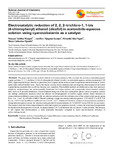Electrocatalytic reduction of 2, 2, 2–trichloro-1, 1-bis (4-chlorophenyl) ethanol (dicofol) in acetonitrile- aqueous solution using cyanocobalamin as a catalyst

View/
Date
2015Author
Wanjau, Tabitha Wangui
Kamau, Geoffrey Njuguna
Mwaniki, Silas Ngari
Muya, Catherine Njambi
Language
enMetadata
Show full item recordAbstract
This paper reports on the catalytic behaviour of cyanocobalamin (VB12) towards the reduction of polyhalogenated
organic pollutant 2, 2, 2–trichloro-1,1-bis (4-chlorophenyl) ethanol (dicofol) in acetonitrile-aqueous solution containing 0.1M
KNO3 supporting electrolyte. Dicofol is a persistent, toxic organochlorine acaricide used in agriculture and horticulture to control
spider mites and soft-bodied mites. Due to the chronic toxicity, bioaccumulation and carcinogenity, determination of persistent
organochlorine pesticides like dicofol has become very important. The available methods are disfavored as they lack necessary
simplicity, inexpensiveness and environmentally friendliness for routine analysis, and consequently, electrochemical methods
have shown to be possible alternatives. Cyanocobalamin being one of the most nucleophilic species known in aqueous solution
can undergo nucleophilic reactions which are efficient for dehalogenation of various organic halides. Direct reduction of
cyanocobalamin exhibited a quasi-reversible two-electron reduction with the oxidation state of the central cobalt species going
from +3 to +1 and E½ of 0.696 ± 0.009 V. Dicofol exhibited a single two-electron reduction peak at -1.182±0.029 V vs SCE. The
E½ was -1.074 V and the diffusion coefficient was 2.21x10-5 cm2s-1. Addition of dicofol to solution of cyanocobalamin resulted in
a large reduction peak at around the reduction peak potential of cyanocobalamin (-0.732±0.018V versus SCE for six scan rates).
This makes it clear that when cyanocobalamin is adsorbed on pyrolytic graphite electrode, it causes the lowering of overpotential
for the reductive decomposition of dicofol by approximately 0.45 V and therefore ∆G was about 1½ times lowered. The decrease
in ∆G implies that electrocatalysis is more kinetically favourable compared to direct electrochemical activation of
carbon–halogen bonds.
Citation
Wangui, W. T., Kamau, G. N., Ngari, M. S., & Njambi, M. C. (2015). Electrocatalytic reduction of 2, 2, 2–trichloro-1, 1-bis (4-chlorophenyl) ethanol (dicofol) in acetonitrile-aqueous solution using cyanocobalamin as a catalyst. Science, 3(1), 1-10.Publisher
University of Nairobi
